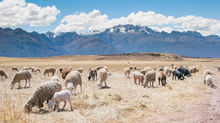Navajo Cuisine: Mutton Meat and its Sacred Role in Traditional Ceremonies and Feasts
- Chambers Meat Co.
- Sep 14, 2023
- 2 min read
Introduction:
Nestled within the breathtaking landscapes of the Four Corners region lies the rich cultural heritage of the Navajo Nation. With its vibrant traditions, the Navajo people have a deep connection to their land, language, and cuisine. One particular culinary delight that holds a significant place in Navajo culture is mutton meat. In this blog, we will explore the role of mutton meat in Navajo ceremonies and feasts, highlighting its cultural significance and the ways it brings people together.
Mutton Meat: A Staple of Navajo Cuisine:
Mutton meat, derived from mature sheep, is a staple in the Navajo diet. The sheep have been integral to the Navajo way of life for centuries, providing wool, milk, and meat. Mutton carries a distinct flavor and tenderness that makes it a preferred choice for various traditional dishes.
Preparing Mutton Meat:
The preparation of mutton meat is a meticulous process that reflects the Navajo's deep respect for their food. Navajo families often raise their own sheep or source them locally to ensure the freshness and quality of the meat. The sheep are carefully butchered, and the meat is traditionally cooked over an open flame or in a horno, a traditional Navajo outdoor oven made of clay. This method of cooking enhances the rich flavors and tenderizes the meat.
Mutton in Traditional Ceremonies:
Within Navajo culture, ceremonies play an integral role in maintaining harmony and balance in the world. Mutton meat is an essential component of many ceremonial rituals, symbolizing the offering of sustenance and gratitude to the deities. The Blessingway ceremony, for example, is a significant event during which mutton stew, known as "Hózhǫ́ǫ́gi", is prepared and shared. Participants consume the stew to strengthen their connection to the spiritual realm and invoke blessings for health and well-being.
Feasting and Community Bonding:
Feasting is an important aspect of Navajo culture, representing a time of celebration and community bonding. Mutton meat is often the centerpiece of these feasts, bringing people together to share in the abundance and to honor the blessings provided by the land and their livestock. Large communal gatherings, such as the Navajo Nation Fair, offer opportunities for families and friends to unite, share stories, and enjoy a variety of mutton-based dishes, including stews, roasted meats, and traditional Navajo tacos.
Traditional Mutton Dishes:
Navajo cuisine boasts an array of mouthwatering mutton dishes, each with its unique flavors and preparation methods. Some popular dishes include Navajo mutton stew, prepared with onions, potatoes, and traditional spices; mutton roast, seasoned with herbs and slow-cooked to perfection; and Navajo mutton tacos, featuring tender meat wrapped in homemade fry bread.
Preserving Cultural Heritage:
The inclusion of mutton meat in Navajo ceremonies and feasts not only sustains the cultural heritage but also serves as a means of passing down ancestral knowledge and traditions to future generations. Through the preparation and sharing of mutton-based dishes, Navajo elders impart their wisdom, storytelling, and cultural values, ensuring the continuity of Navajo practices and identity.
Conclusion:
Mutton meat holds a sacred place in Navajo culture, deeply rooted in traditions, ceremonies, and communal feasts. Its significance goes beyond culinary delight, symbolizing spiritual























Comments